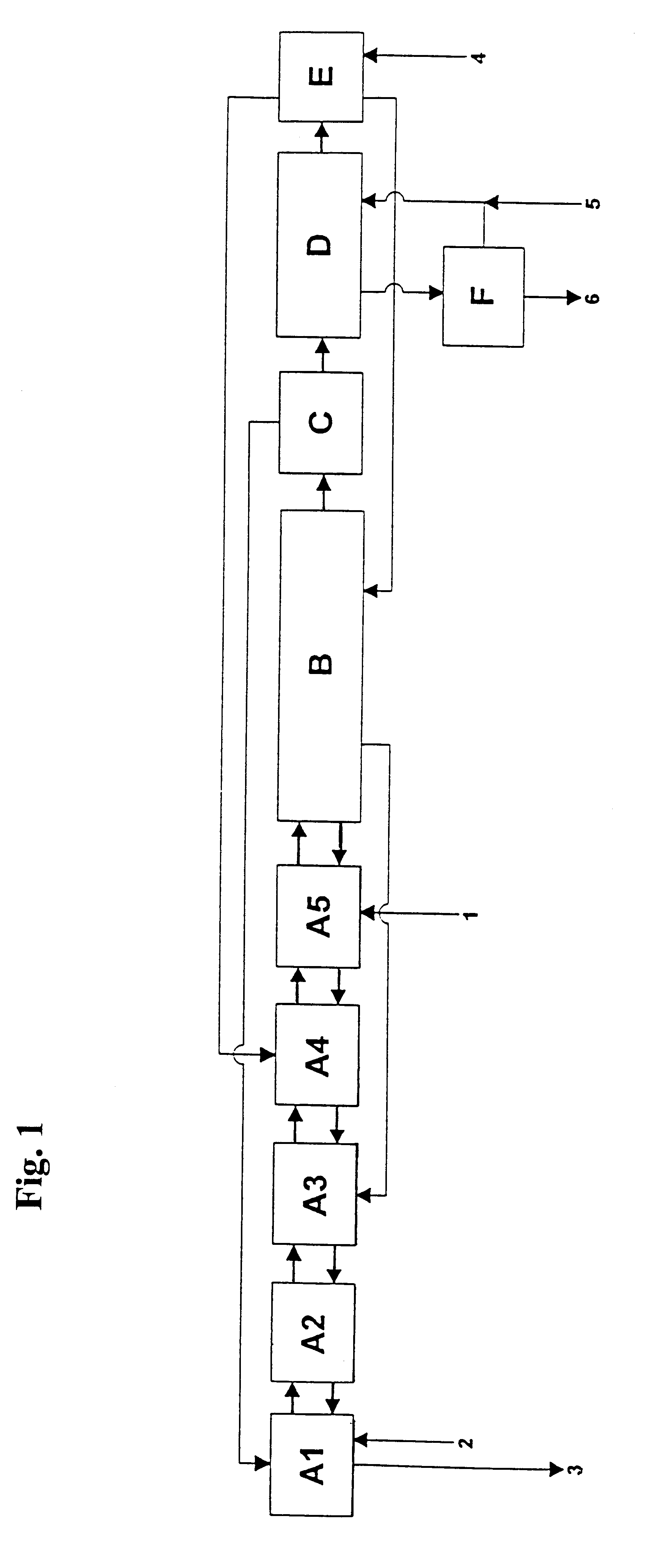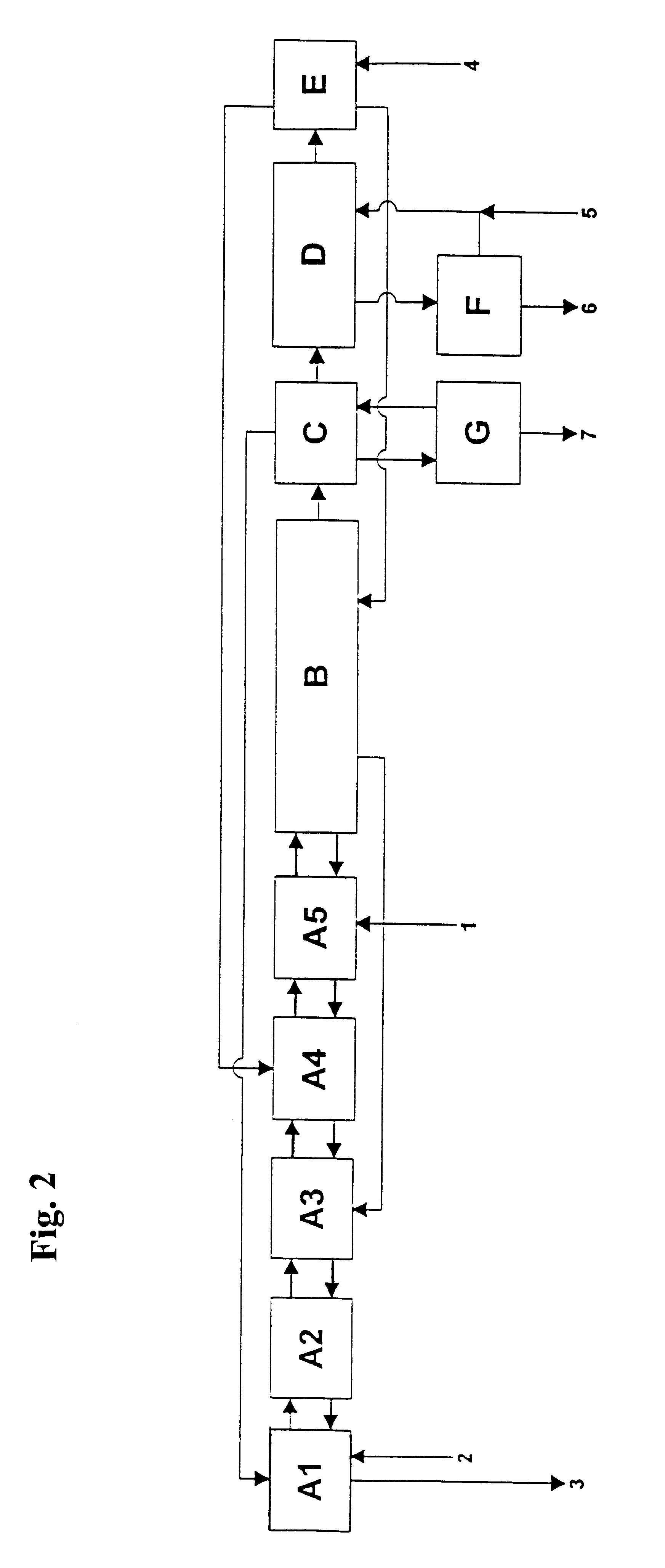Wet-process technique for refining phosphoric acid
- Summary
- Abstract
- Description
- Claims
- Application Information
AI Technical Summary
Problems solved by technology
Method used
Image
Examples
example 2
In this experiment, the same alcohol mixture as described in Example 1 is used. The volumetric ratio alcohol mixture:phosphoric acid is 4:1, however. A commercially available prepurified green phosphoric acid which was prepared by digesting calcined Israeli phosphate with sulphuric acid is used. It has the following chemical composition:
10 l / h of this phosphoric acid are passed through in a similar manner to the process described in Example 1, but with the difference that the extraction is only performed in one battery of a total of 3 mixer-settler vessels in such a manner that the green phosphoric acid is extracted in stage A(3) with 41 l / h of the phase from stage A(2) which comprises alcohol mixture / phosphoric acid / water. The bottom phase produced in this case is treated once more in stage A(2) with 28 l / h of water-saturated and circulated i-amyl alcohol and 13 l / h of phase from extraction stage A(1) comprising isopropanol / phosphoric acid / water. The bottom phase from stage A(2) is...
example 3
In this example, a solvent mixture consisting of 60% by volume of diisobutyl ether and 40% by volume of isopropanol was used. The volumetric ratio of phosphoric acid to solvent mixture was 1:4.
10 l / h of green phosphoric acid used in Example 2 are extracted with 40 l / h of solvent mixture as described in Example 1. The difference from Example 1 is that the bottom phase from stage A(4) is continuously mixed with the wash solution from the battery B (FIG. 1, B) and extracted with 16 l / h of phase from stage A(2) comprising isopropanol / phosphoric acid / sulphuric acid / water. The bottom phase from stage A(2) is mixed with 0.2 l / h of a 94% strength sulphuric acid and extracted in counter-current in the stages A(1) to A(3) with 16 l / h of isopropanol from the distillation stage. 1.7 l / h of raffinate having a P.sub.2 O.sub.5 content of 10.5% by weight are produced in stage A(1), which corresponds to a P.sub.2 O.sub.5 loss of 2.99%, based on the feed P.sub.2 O.sub.5.
After the solvent mixture / phos...
example 4
In this example, a solvent mixture consisting of 60% by volume of methyl isobutyl ketone and 40% by volume of isopropanol is used; the volumetric ratio of solvent mixture to phosphoric acid is 4:1.
10 l / h of green prepurified phosphoric acid are extracted with 40 l / h of solvent mixture as described in Example 3. 1.5 / h of an aqueous raffinate having a P.sub.2 O.sub.5 content of 11% by weight are produced, which corresponds to a P.sub.2 O.sub.5 loss of 3%, based on the feed P.sub.2 O.sub.5. In the reextraction stage, 13.5 l / h of a purified phosphoric acid having a P.sub.2 O.sub.5 content of 40% by weight are isolated using 6 l / h of water. The yield is 97%.
The analytical data of the pure acid are summarized in the listing in ppm based on % P.sub.2 O.sub.5 :
PUM
 Login to View More
Login to View More Abstract
Description
Claims
Application Information
 Login to View More
Login to View More - R&D
- Intellectual Property
- Life Sciences
- Materials
- Tech Scout
- Unparalleled Data Quality
- Higher Quality Content
- 60% Fewer Hallucinations
Browse by: Latest US Patents, China's latest patents, Technical Efficacy Thesaurus, Application Domain, Technology Topic, Popular Technical Reports.
© 2025 PatSnap. All rights reserved.Legal|Privacy policy|Modern Slavery Act Transparency Statement|Sitemap|About US| Contact US: help@patsnap.com



